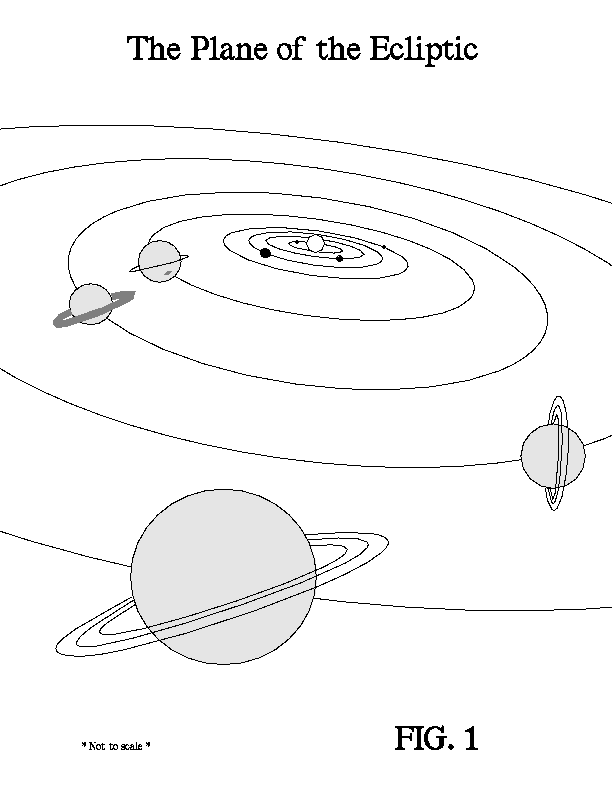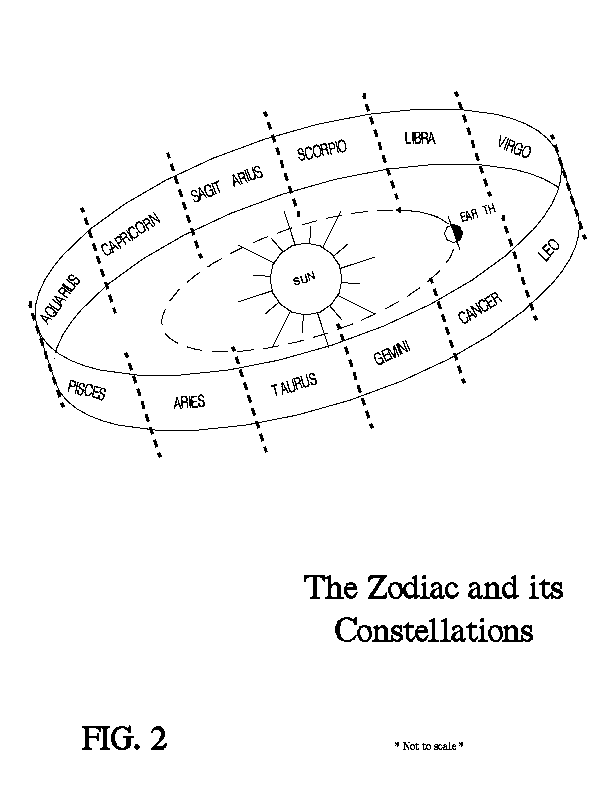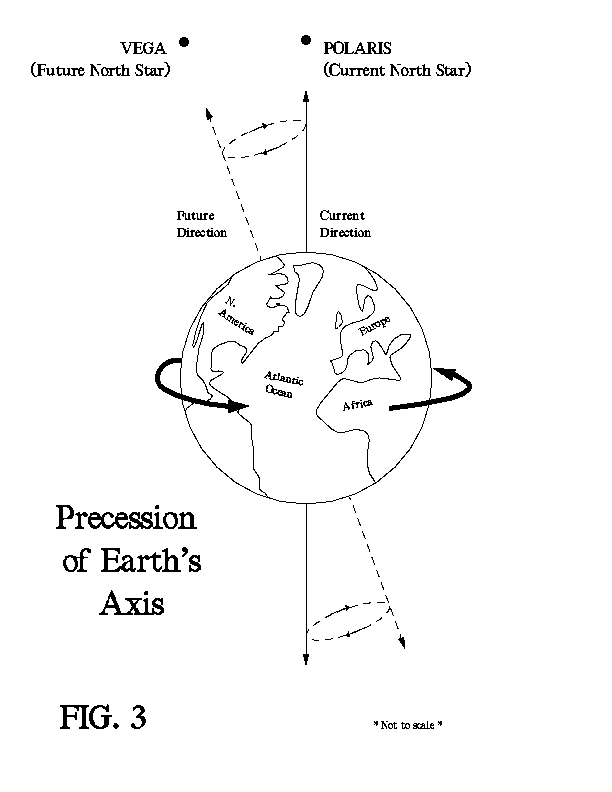
by Beth Napier
At the earliest time of human existence, no one was aware that Earth was rotating around its axis. Early astronomers watched the sky and saw various cyclical motions of celestial objects such as the Sun, Moon, stars, and planets that had periods or cycle times ranging from 24 hours to a year. A natural assumption that resulted from observations was that the reason why the Sun, Moon, planets and stars rose and set every day was due to their own motion around the Earth. Now we know that these so-called diurnal or daily motions are the result of the Earth's own rotation or spin about its North-South axis with a period of 24 hours.
In early times, objects in the sky were believed to be affixed to transparent celestial spheres and their motions were thought to be a result of the motion of these spheres as they revolved around the Earth. Groups of bright stars were observed to form prominent patterns in the night sky called Constellations, which have been historically ascribed to mythological figures, such as Orion the Hunter, and Gemini the Twins. The early astronomers recognized that constellations "appeared" and "disappeared" with the change of the seasons throughout the course of a year. The Sun, Moon and planets were observed to move in relation to the fixed background of stars, or constellations. Because of their perspective from Earth, early astronomers observed that all the planets visible with the naked eye as well as the Sun seemed to pass in the course of a year through a region in the sky occupied by twelve specific constellations.
More than 3000 years ago, astronomers wondered how the sky would appear if the stars could be seen during the daytime. Based on their observations of the night sky, some astronomers determined that during the daytime, the Sun would appear to "enter" or pass through a different constellation each month. These twelve constellations are called the Zodiac. Many ancient people believed that a person's behavior, emotions, and fate were heavily influenced by the month of that person's birth--ie. that person's astrological sign. Even today, thousands of years later, some people still believe in the powers of the zodiac and read their horoscopes for daily guidance. However, many people read their horoscopes for fun, not because they believe in predictions.
While making its daily rotations around its axis, the Earth is also making yearly revolutions as it orbits around the Sun. The Earth travels in space as it revolves about the Sun in a planar orbit that is approximately circular. This motion of the Earth makes the Sun appear as if it is moving eastward in the course of a year against the background of the zodiac constellations. This apparent motion of the Sun is caused by our changing point of view or viewing direction as we observe from the surface of the Earth as it moves in its orbit. The path in the sky defined by this apparent motion of the Sun (which is actually the plane of the Earth's revolution about the Sun) is called The Plane of the Ecliptic .
It turns out that most of the other planets in the solar system also revolve around the Sun in orbits that lie approximately along the same Ecliptic plane. Try to imagine that the Sun sits in a hole in the middle of a large, round cake pan. If the planets were marbles, they would roll around the Sun only on the surface of the cake pan and would not move to another pathway or to a higher or lower level. It turns out that one of the nine planets does not orbit the Sun in plan that lies close to the Ecliptic, and this is Pluto, the farthest planet from the Sun. Pluto's orbit lies about 17.5 degrees out of the Plane of the Ecliptic. This orbit causes Pluto to lie either above or below the Plane of the Ecliptic most of the time. Figure 1 below shows a diagram of the Earth orbiting the Sun along the Ecliptic, as well as the other solar system planets orbiting the Sun approximately along the plane of the Ecliptic. Pluto's orbit is not included in Figure 1, so you may well want to challenge your students to draw Pluto's orbit on the diagram.

The Zodiac constellations, as envisioned by ancient astronomers, were ascribed specific patterns that resemble the shapes animals, half-animals, and human beings. The Constellations of the Zodiac actually form an imaginary belt in the sky that extends about eight degrees above and below the Plane of the Ecliptic. In Figure 2 below, The Constellations of the Zodiac, we are looking at the Earth from far out in space. We must keep in mind as we look at the names of the zodiac constellations that at any given time of the year, the Sun is between Earth and one of these constellations.

We are familiar with the Earth's Equator because of our knowledge of geography. If we could extend the earth's equator into space so that it could be viewed against the background of stars, we'd be able to see what modern astronomers call the Celestial Equator. Because the Earth's axis of rotation is tilted with respect to the Ecliptic (or orbital plane of the Earth about the Sun) by 23.5 degrees, the Celestial Equator and the Ecliptic do not lie on the same plane, but cross each other at an angle of 23.5 degrees. The two points in the sky where these two planes (Celestial Equator and Ecliptic) cross are called the Equinoxes. We call the Vernal Equinox the intersection point where the Sun, in its apparent motion against the background stars along the Ecliptic, crosses the Celestial Equator from south to north, usually occurring around March 21. Similarly, we call the Autumnal Equinox the intersection point where the Sun, in its apparent motion against the background stars along the Ecliptic, crosses the Celestial Equator from north to south, usually occurring around September 21. The first day of Spring then corresponds to the Vernal Equinox and the first day fo Fall corresponds to the Autumnal Equinox. During the time of the Equinoxes, we on the Earth experience twelve hours of day and twelve hours of night.
The Earth's rotation on its axis has caused the Earth's shape to diverge from a sphere, and has caused the Earth's equatorial regions to bulge out, in the same way that a skater's skirt spreads outward as she spins rapidly on the ice. Because the Earth's equator is tilted with respect to the orbital plane of the Earth around the Sun, the so-called Ecliptic plane, the Earth's equatorial bulge is also tilted with respect of the plane along which the Sun and Moon travel. The Moon and the Sun exert a gravitational "tug" on the Earth's equatorial bulge, trying to pull the Earth's equatorial region to be aligned with the Ecliptic plane. This tug, along with the rotational motion of the Earth on its axis, the revolution of the Earth around the Sun, and the revolution of the Moon about the Earth, cause the Earth to wobble about its axis of rotation, similar to the motion of a spinning top. This motion is called Precession. An extension of the Earth's axis out into space traces out a conical figure with a time cycle or period of 26,000 years. Figure 3 below shows a schematic of the Earth's precession. The Earth's precession implies that although Polaris is currently the star above our North pole, in about 13,000 years Vega will become our North star; only, after yet another 13,000 years, will our North pole will once again point towards Polaris.

According to astrology, a person's sign is determined by the position of the Sun on the date they were born. Namely, a person is born under the sign of Virgo if the constellation Virgo was behind the Sun at the time of birth. Thus, a person can see their sign constellation approximately 6 months after they are born, since we must wait for the Earth to travel to the other side of the Sun to see the constellation at night.
According to astrological traditions, the Vernal Equinox is the day that the Sun "enters" the constellation Aries. However, this is not always the case, as astronomical observations have found. It turns out that the Earth's precession makes this astrological prediction wrong. The Earth's precession causes the Equinoxes to move with respect to the background constellations of the Zodiac. Because of the Earth's precession, the dates of the Equinoxes gradually change over a 26,000 year cycle. This means that currently the constellation which is behind the Sun, is actually different from the one predicted by astrologers. For example, according to traditional astrology, the Sun is "in Gemini, the Twins" between May 22 and June 21; but when a person looks at the nighttime sky, the constellation of Gemini is easily visible above the western horizon after sunset all through the month of May until around June 20.
Grade Level: 7 - 12
Pre-requisites:
For further information and activities on this subject: